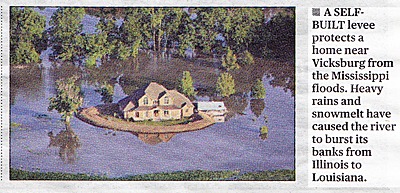 I was pleased to see that our post on Waffle cities: landscape planning, urban design and architecture for flood-prone regions and global warming has been verified as feasible. The snippet (courtesy of London Evening Standard 20.05.2011) shows that a homeowner in Vicksburg has made his home into the ‘cell of a waffle’ and that the self-build levee protected his home from the Mississippi floods of spring 2011. Congratulations!
I was pleased to see that our post on Waffle cities: landscape planning, urban design and architecture for flood-prone regions and global warming has been verified as feasible. The snippet (courtesy of London Evening Standard 20.05.2011) shows that a homeowner in Vicksburg has made his home into the ‘cell of a waffle’ and that the self-build levee protected his home from the Mississippi floods of spring 2011. Congratulations!

Yes. Any suggestions for Oklahoma City?
Difficult to deal with floods and tornadoes at the same time.
That’s very impressive! I lived in Vicksburg until 2005… the hurricanes and floods and such got to be too much for me. Now I’m on higher ground, but I’m glad to see someone stayed and still avoided the flood!
Perhaps a snow dome tornado cover? [ http://www.snowdomes.com/ ] Maybe it could be inflatable or retractable?
There is nothing new under the sun http://www.ecofriend.com/entry/eco-homes-solar-powered-houseboat-can-survive-the-harshness-of-the-ocean/
I do not think I would sleep too well behind this private levee http://www.heavyequipmentforums.com/attachment.php?attachmentid=80196&d=1306132978
Thankyou for the example of the marine snow dome. The mobile marine alternative is considered the design of last resort in flood competitions.[ http://inhabitat.com/six-flood-proof-buildings-that-can-survive-rising-tides/arcology4-2/?extend=1 ]
Another example terrestial example might be the pyramid house. [ http://www.geeks.co.uk/1613-revolutionary-new-house-design-walks-on-water ] Yes, perhaps only a marine engineer would get a good nights sleep behind that levee!
But the issue is a serious one and with climate change increasing the risk we will all want to continue to get a good nights sleep.
As Jeroen Warner says in his book ‘Flood Planning: The Politics of Water Security’ “One person in ten worldwide, including one in eight city dwellers, live less than 10m above sea level and near a coast. Flooding is the most common type of natural disaster worldwide – 40 percent of all natural disasters…Floods account for 15 percent of all deaths related to natural disasters.” p1.
In the United States according to Donald Watson and Michelle Adams in ‘Design for Flooding: Architecture, Landscape and Urban Design for Resilience to Climate Change’ flooding is the most common natural disaster accounting for one in three federal disaster.
Perhaps by making city models within a flood tank and exploring the consequences of our designs we might begin to make some improvements? [ http://www.wokmedia.com/?p=44 ]
I think the most convincing solution to the problem was developed a long time ago, on Lake Dal.
Thankyou.
[ http://en.wikipedia.org/wiki/File:Srinagar.jpg ]
I found the following information on Lake Dahl from the International Lake Environment Committee fascinating:
“The famous Moghul gardens around the lake have been laid during 16-17th century and their number was about five hundred but now only a few of these have survived.
The origin of the lake has remained unresolved. It is believed by some geologists that the Dal Lake is the remnant of a Pleistocene oligotrophic lake which once covered the entire valley of Kashmir. There are other geologists who believe Dal to be a flood plain lake. The lake water is being used for irrigation of vegetable fields which have grown in number and extent during recent years. The present maximum depth of the lake is 6 m (Nagin basin). Many aquatic plants growing in the lake are used as food, fodder and compost.
The water quality of Dal Lake has deteriorated considerably in the last two decades. Large peripheral areas have been reclaimed and converted into floating gardens. With the increase in the tourist influx a large number of residential buildings, restaurants and hotels have come up along the lake front. The number of house boats has also been increasing at an alarming rate. As a result of rapid and unplanned urbanization, large quantities of raw sewage are discharged in the lake water, which might pose health problems in the near future.
The main environmental issues are excessive weed growth, reduction in water clarity, enrichment of waters and high microbial activity. A Dal Development Project was formulated in 1978 and the State Government of Jammu and Kashmir adopted it with some modifications. The main thrust of the project is to improve the lake environment by using both physical and biological approaches.”
There are two current theories about the origins of the lake 1) it is the remnants of a post-glacial lake and 2) that it is an old flood spill channel from the Jhelum River. It is also feed by numerous springs, however no one is sure of the precise contribution these springs make to the water body.
Lake Titicaca in Bolivia is another example of a lake, in this instance an inland seawater lake, the origins of which are still unknown. [ http://www.flickr.com/photos/yandi/364126066/ ]
I like that idea of lake Dahl having a mysterious origin. It suits with its romance.
But I do not like the idea of it being swamped with tourists. There were heavy monsoon floods, and a few bombs, in the weeks before my visit, with the happy result (for me) that the hotels and restaurants were empty. The flooded roads were fun too but the string of overturned and abandonned vehicles was a little worrying.
It seems you are not the only one concerned with the destruction of the Kashmiri heritage. [ http://naveed-qazi.blogspot.com/2009/03/dal-lakethe-dying-heritage.html ] The problem seems to be finding a balance between development and environment that is sustainable. The economics of this, both for development and conservation is all important.
The potential impacts of climate change is an added complication in this equation.